Hello everyone!
Initially I wanted to write about Standard, but I didn’t expect to make top 4 at GP Kyoto and I think it would be a shame to not write a report from such an incredible event.
It all started a couple of months ago, when my friends Tom “Tomfa” Ristovsky and Pavel “Pablo” Matousek asked me to join them for a team event in Japan. At first I was a bit hesitant, but they convinced me and promised me that they will do whatever it takes to be as prepared as possible so we can make it to the top 4 – which was our goal as both Tom and Pavel wanted to qualify for the PT. The fact that Japan is by far my favorite country in the world, and I will be able to try my Japanese skills for the first time was what pushed me to go for it.
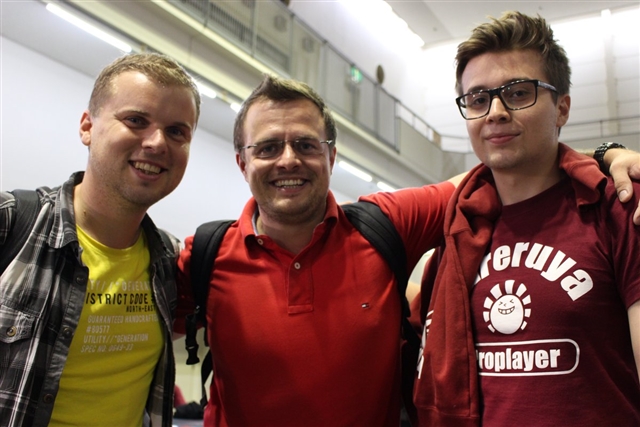
Tom, Pavel and I had several team practice sessions in the time leading up to the event, where we discussed certain cards, our overall strategy and what to do when we open our pool, so that we don’t waste the precious time etc. On two occasions we even invited another three players, so that we could try actually playing against an opposing team.
Awesome JapanWe got to Japan on Wednesday during the week before the event. We spent two days in Kobe and enjoyed some sightseeing (most notably [the Himeiji castle]). I have to admit, that I was a little afraid that Japan would disappoint me and it won’t be as awesome as I always thought, luckily it was even better! Japan is just insane, everything is pretty, clean and cool, the people are nice, good looking and helpful and you can experience and see all kind of different and unusual things, that you wouldn’t be able to do anywhere else.
We got to Kyoto on Friday and went to the GP site during the day, to make sure we can find it the following day and double check that we are properly registered. I also said hi to Saito and a couple of my other Hareruya teammates and then we headed back home. I have to say, that I was really impressed with the way the Japanese GP looked; there were many cool aspects, that I would like to see in other GP’s as well and it seemed a bit more professional overall. We went to sleep early, to be in good condition for Saturday with hopes of an insane pool stacked with bomb rares.

We were very fortunate, when we asked for an English pool, because they took us to a different area, where we had a lot more space. Our sealed strategy was as following: Tom takes care of blue and red, I have black and white and Pavel has the rest – first you get rid of the unplayables, then you separate the colors into very good cards, that you will most likely play in that color and the other remaining playables into another pile. You make the mana curve from the very good cards in each color, which helps you see what the color could be paired with. We also took a look at any potential broken synergies like emerge, delirium, spells, humans etc.
 |  | 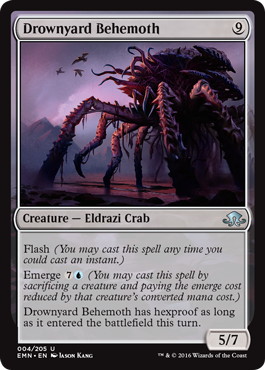 |
Thanks to Pavel we were able to quickly ascertain, that we want to make a G/W emerge deck splashing blue, using desperate sentries as our main emerge enablers. He started to work on the deck and in the end it looked very promising – just a very solid midrange deck with a lot of powerful cards and just enough removal – the MVP was 《Ongoing Investigation》, which is obviously absurd.
The problem of our pool, wasn’t the GW deck though. We had only about 4 playable rares in the entire pool and they weren’t even bombs – the ones we ended up playing were: 《Bedlam Reveler》, 《Heron's Grace Champion》, 《Imprisoned in the Moon》 and 《Nephalia Moondrakes》. Don’t get me wrong, all of these are very good cards, but we had hoped for something a bit better.
The problem with this format as a whole is that it’s really hard to succeed by just playing random good cards – especially if you don’t have enough removal – people are just going to go over the top of whatever you are doing. I can explain this easily – imagine that you are playing a regular U/W flyers deck – you have a nice curve, some tempo spells etc. and your opponent is playing U/G emerge deck. In an average limited format, this matchup would favor the U/W deck by a significant margin, but the U/G deck is built around synergy, so they will sometimes have the nut draw and go emissary into an emerge creature and crush you no matter what you do, which significantly influences your win percentage – your U/W deck is simply not capable of doing something like that, the best you can hope for is to curve out well. This was just an example, but I hope my point gets across.
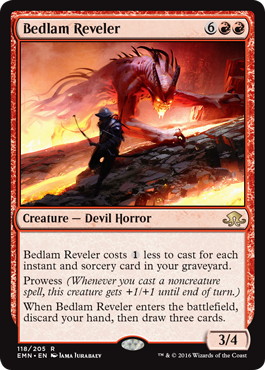 | 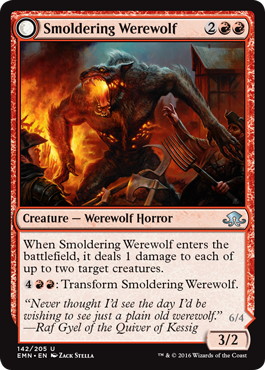 | 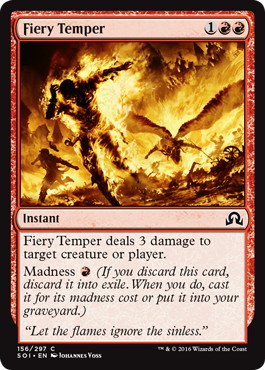 |
We were able to make a pretty good U/R spells deck and a very mediocre R/B madness aggressive deck. The R/B deck was pretty crappy, but we figured that it has potential to have some really strong draws and making it just a little better by weakening the other 2 decks, wouldn’t really help anyway.
Most players presume that the strongest player (usually sitting in the middle, but there are exceptions; for example if your team consists of 2 strong players and one weaker, it is better to have the weakest player in the middle, so that he can ask for an advice more regularly) should play the hardest deck, but that is just not true, I think that it’s a lot better if the strongest player is on the most straightforward and fastest deck, because that way you can give advice to teammates more often and more importantly, if you finish your match first, you can then play the remaining games together with your teammates.
In the end I played the R/B deck, Pavel played the emerge deck and Tom played the U/R spells deck and we were ready to battle. We lost the first round very easily and it wasn’t looking that much better for us in the second match – I lost, Pavel won and Tom went to a decider, where he mulliganed and missed a third landdrop, while his opponent was building up his board presence. At that point I thought that we lost and I started thinking about, why am I so bad at this game.
I had no clue what was going to happen from that moment on though – Tom started drawing lands and started to stabilize a little bit. It was obviously still looking horrible and at some point we got to the following spot: both we and our opponents had bunch of random creatures on the board, but they had two 1/1 flyers and we are at 4, we had 5 lands, two seven-drops in our hand and a counterspell. We pass the turn and something insane happens. They attack us down to 2 and instead of just passing the turn, play a 《Certain Death》 with the intention to kill us – no matter how unlikely it might have been for us to have the counterspell (it was actually pretty likely I think), there is no way, that you should play your card into it there – your opponent is clearly dying to the board and if they want to survive, they will most likely have to tap out for something, at which point you just kill them.
 | 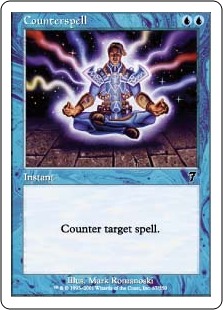 | 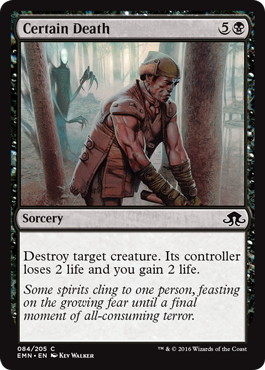 |
Anyway we slammed the counterspell and we drew a 《Smoldering Werewolf》 (!!!), killed the 2 flyers and we were able to win from that point out. We breathed a sigh of relief and went back to battle. We were very fortunate in our matches and ended the day at 7-1-1 with a concession from a team that we would have drawn against otherwise, so big props to them! We went immediately to bed afterwards knowing, that we are still live, but we would also have to get a perfect record to even start thinking about the top 4.
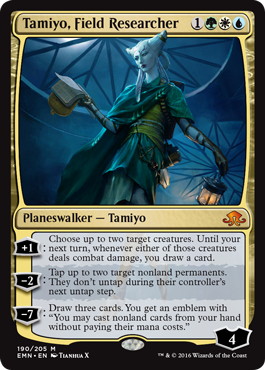 | 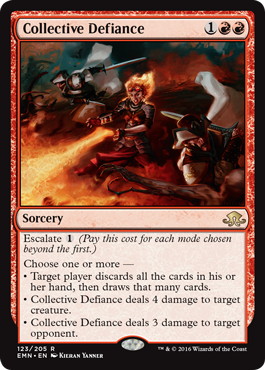 |
Day 2
The second sealed was way tougher to build, because this time we didn’t get as much space – someone probably complained, that it was unfair to the Japanese competitors on day 1 and they changed it. It makes sense, but it made life a lot more difficult for us. Luckily our pool this time was awesome – we opened 《Tamiyo, Field Researcher》, 2 《Tireless Tracker》, 《Collective Defiance》, 《Heron's Grace Champion》 and an otherwise strong pool overall. U/G emerge decks splashing 《Tamiyo, Field Researcher》 was an obvious choice, the question was what to do with the remaining decks – at first we had a really strong B/W midrange deck highlighting 《Drogskol Cavalry》 and a R/G deck. The problem was that even though the cards in R/G were fine individually, the curve was awful and don’t get me wrong, I think that the curve is way less important than other people (in fact, I would almost never play a significantly worse card just because it fits the curve better – yeah it looks good on the paper, but in the actual games, it’s usually better to just have a better card in your deck – especially if you’re flooding) especially in sealed, but that’s not the case for most R/G deck.
The thing about R/G is that it plays bunch of underpriced creatures and then cards that helps you push your advantage like burn spells, 《Blood Mist》 etc. In a deck like that, you just can’t afford to not curve out regularly. It doesn’t matter that much that your creature for 4 mana is a little bit bigger than your opponent’s 4 drop if you didn’t play anything before that, they can easily kill it or just take some damage and your pump spells and other support cards are not going to do anything, not to mention that burn spells aren’t very good in lategame, where the small creature don’t matter that much. Add the fact that you almost can’t deal with opposing bombs and you have a recipe for trouble. For these reasons we opted to play two pretty good decks – G/W aggro with 18 creatures, 2 overruns and 3 removal spells and R/B deck (this time it wasn’t really aggressive or built around madness – it was just a bunch of very good R/B cards). Yeah the B/W deck was better than both of these, but I think that the overall strength of these 2 decks was greater than the B/W deck + R/G deck, so we went with that.
Our decks worked out even better than we expected and all of the sudden we have find ourselves 2 matches away from the top 4. We were paired against an all-star Japanese team featuring Kentaro Yamamoto, Hiroaki Kitahara and Ken Yukuhiro. My draws were great in both games I played and I won relatively easily. Ehile Tom had mana issues and lost to Kentaro. Meanwhile Pavel was down a game against Ken Yukuhiro and his U/W flyers deck. We were also under significant time pressure, so Pavel agreed, that he will just hold cards for this game and make the plays I tell him to save time. Normally I am relatively slow player, as I am trying to figure out everything, but I can switch to a fast mode when needed, which means that I won’t figure out every detail and those 50/50ish scenarios, but I can still play ABC Magic. It’s important to realize, when it’s better to switch to this mode, because playing perfectly will not always bring you the highest win percentage – often is time the main concern and playing fast is more important. For example: let’s say that if I play slowly and perfectly I will win the game in 20% times and draw in the remaining 80%. The other option is to play faster and win 45%, draw in 30% and lose in 25% – it’s usually better to just play faster.
Also at this point a draw was useless for us (or at least, that’s what we thought at the time), which makes it even more obvious. Anyways, we were able to win the match on the back of 《Tireless Tracker》’s insane power and we were asked for an interview for niconico channel about how we formed our team and other normal questions with Shuhei Nakamura, which was awesome.
We started realizing, that we are actually one match away from getting what we came here for – the top 4 and we started to get seriously nervous. We looked at the standings before the last round and it seemed like we have to win to get in. If we drew we would likely end up fifth, because we expected concession on the 3rd table from the team, that already didn’t have a chance to get to a top 4. We knew, that it was unlikely, but we still asked our opponents in the last round (Ichikawa, Matsumoto and Takimura), if they would consider to concede (they would get in for 100% even with a loss), but they wanted to have the highest seat in the top 4, which made obvious sense and I would probably do the same in their spot.
 |
I won my match and Pavel lost his, so it was up to Tom, who was up a game. Once again we agreed that I will make most of the plays, because we were running out of time. Our draw in game 2 was very mediocre and I think I messed up at some point. It was turn 4 and we had 5 reasonable options to play and it all depended on what they have. Game 3 we had a nut draw – curve out with efficient creatures and all we needed was 1 good card that would push our advantage, but we weren’t able to find one. At some point we had to take a calculated risk and attack with everything – if they have something, we lose, if they don’t, they go to 1 and we have 1 more creature in play than them (they need to discard their hand to do this and bring back 《Haunted Dead》), which means that if they blank on their draw step, we win.
We went for the attack and it worked out, but they were able to find a creature on top of the deck, so we needed a good draw step to finish them off. Unfortunately we ran out of time, also the winning card was on the top of the deck after we had used up all our extra turns, which felt really, really disappointing, unfair and horrible. I didn’t know what to do and my teammates were also completely devastated by this turn of events. Then, like a godsend Shota Yasooka came to us and said: “table 3 draw, top4”. I couldn’t believe what I just heard and screamed In Japanese at Shota; “really?!” He smiled and confirmed it. It was a great feeling and immensely satisfying. It’s like when you think you have lost your wallet, you go through everywhere you’ve been in the last day and then you go home to find it lying on the table.

Top 4 Draft
We took some photos, filled out an interview (very different answers, then the ones that are on wizards site – most likely my mistake – my handwriting is often very hard to decipher) and we were seated for the top 4 draft. I haven’t played that many team drafts in my life and the same was true for both Pavel and Tom, so we didn’t think very highly about our chances. That being said, I knew at least something and this is some of the advices I gave them: It’s harder to have a good deck build around synergy or relying on certain cards, because there are fewer boosters opened, which means that individually strong cards are higher picks.
Midrange and control decks are overall a little bit stronger than aggro decks. With aggro, you need to have a good curve and strong early-game creatures, but that’s way harder to make with only 6 boosters, also it’s much harder to splash in an aggressive strategy. If you have a bad green midrange deck, it’s way better than a bad aggro deck, because an inefficient big body is still a big body and you can kill people with it. It’s a lot harder to do that with random 2/1s and 3 mana 2/3s. This also signifies that mana fixing is better, because you are often forced to splash from lack of playables. I also told them to try keep a track of what are they passing, because given that we will know who our opponents are, we can adjust our main deck accordingly.
The draft went very poorly for me, I first picked a 《Gnarlwood Dryad》 over bunch of stronger red cards, because I didn’t want to fight for that colour and I liked green a lot, because of what I explained above. Unfortunately, I was kind of forced to jump into red couple packs later, because the red card in 《Vildin-Pack Outcast》 was by far the strongest card in the pack and I thought that the color might be opened from my right. This was a crucial mistake, because I forgot how much are people underestimating this card – think about it, would you take this card higher if it was a mythic rare? Would you think of it as a bomb? If any of the answers are yes, then you should probably reevaluate the way you think about magic. Anyway, that is exactly what 《Vildin-Pack Outcast》 is: Mythic bomb rare. I took a couple more red cards including Pyrokenesis, but then the red stopped flowing and even though green was open I was short on couple playables in the end, so I had to play awful cards like 《Hulking Devil》 and 《Village Messenger》.
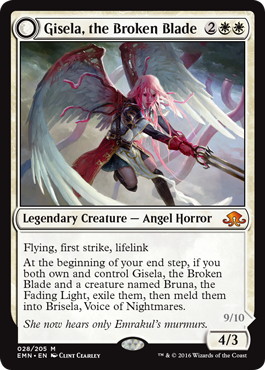 | 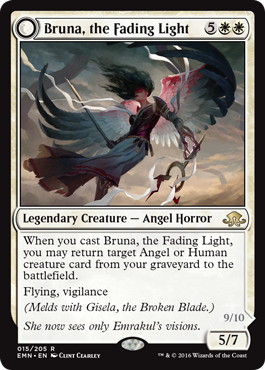 |
Pavel’s deck was an insane b/w midrange deck featuring both 《Bruna, the Fading Light》 and 《Gisela, the Broken Blade》, Tom had a pretty good boros deck and my deck was bad It had some potential though – I had two copies of waxing moon and 6 werewolfes, including two mana guys, 《Shrill Howler》 and morphling, which were all insane to flip early and could easily steal a game.
Pavel won his match very easily on the back of his insane rares and Tom lost, so it was all up to me. I was already down a game, but my draw game 2 was pretty good, so I thought that I am going to win. That would be true, had I not made a crucial mistake – I was very ashamed afterwards, as this is something that a platinum pro should never do and I am once again really sorry for my teammates. All I had to do, was to steal Yuuki’s Big creature and then emerge it away – I just didn’t see it and I realized it, when it was too late and I had already used my mana to play an irrelevant two drop. I was very, very mad at myself, but there was nothing we could have done at that point.
We shaked hands with the eventual winners of the tournament (big congratulations) and the tournament was then over for us. Despite the disappointment from the last game, the result was still really awesome for us, a top 4 added to all of our resume’s, 4 pro points, cash and most importantly; an invite to the Pro Tour for my teammates.
We had a great celebration party in Kyoto that night and then it was time to go back to Czech Republic. I will admit; it was hard for me to leave, but the fact that I will come back for PT Kyoto next year made it bearable.
I hoped you liked the report and I would appreciate if you follow me on twitter or add me on facebook, so that you know about the new articles immediately!
Thanks for reading, Petr Sochurek
Share in Twitter
Share in Facebook
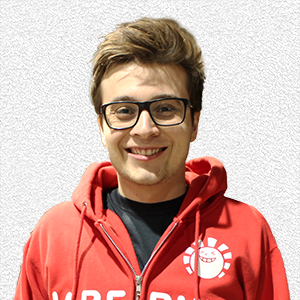 Petr Sochurek
Petr Sochurek
His prowess in reading the meta and taking advantage of it with flawless plays is among the reasons he is considered to be one of top European players right now.
Having played Grixis Control to a magnificent victory at GP Paris 2016.
He is most assuredly one of the top players to keep an eye on right now!

Related Articles
- 2016/09/13
- Yuta Takahashi’s Pro Tour: Eldritch Moon Top 8 Report
- Yuta Takahashi



